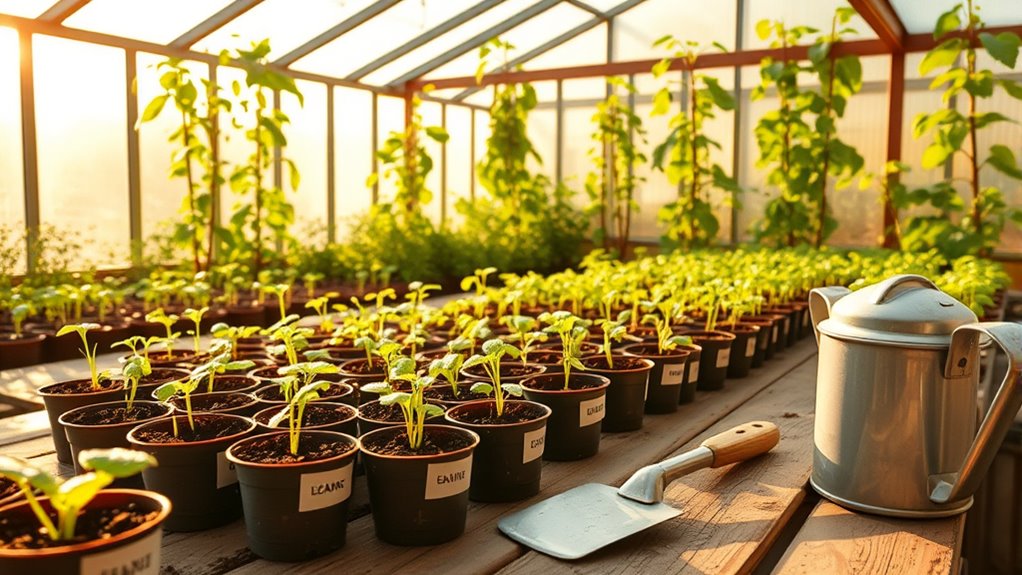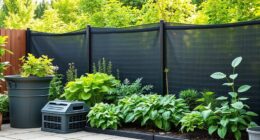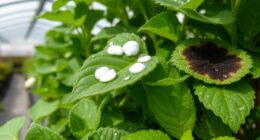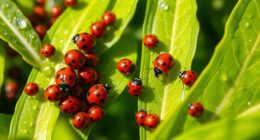Starting your greenhouse journey is so rewarding! I recommend picking a sunny spot for at least six hours of light each day and choosing sustainable materials for your build. Master soil management and consider organic fertilizers for healthy plants. Don't forget about ventilation and temperature control – they're essential for thriving plants. Crop rotation can keep your soil healthy, too. If you're keen to learn more about greenhouse gardening, I've got plenty of tips to share!
Key Takeaways
- Choose the right greenhouse type and materials that suit your local climate and budget, ensuring proper ventilation and insulation.
- Plan your planting schedule with a year-round calendar to maximize productivity and manage temperature effectively in your greenhouse.
- Utilize organic gardening techniques, including crop rotation and sustainable pest management, to enhance soil health and promote eco-friendly practices.
- Maintain optimal humidity and temperature levels through proper airflow and watering adjustments to prevent mold and ensure healthy plant growth.
- Engage with gardening communities and resources to enhance your knowledge and share experiences, fostering continuous learning and improvement.
Greenhouse Gardening for Beginners: Build Your Own Greenhouse and Grow Organic Vegetables and Fruits
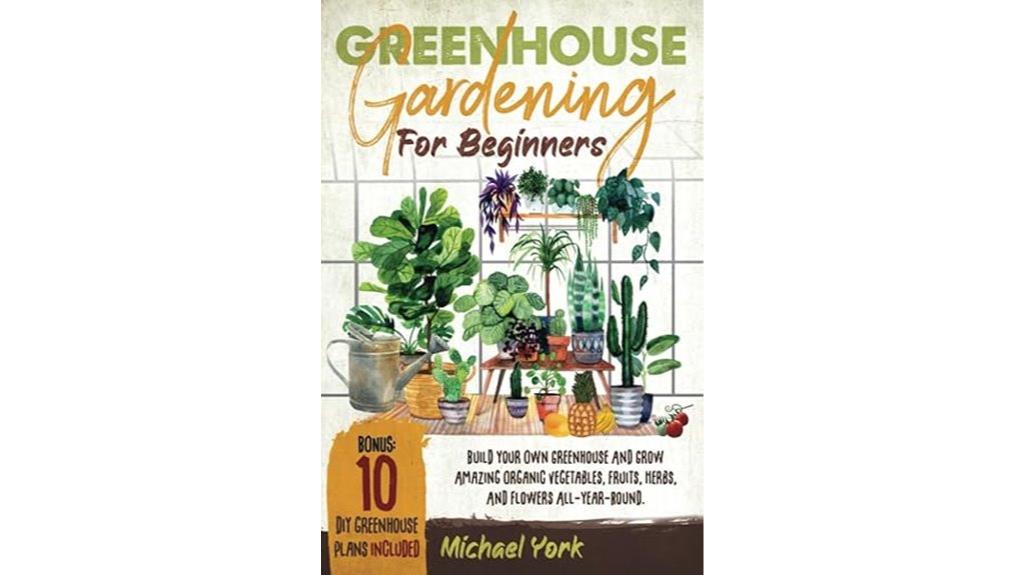
If you're a novice gardener enthusiastic to grow your own organic vegetables and fruits, "Greenhouse Gardening for Beginners" is the perfect guide for you. This book offers clear, step-by-step instructions on building your greenhouse and managing essential conditions like temperature and humidity. I found the practical advice on pest management and extending the growing season particularly helpful. With a focus on organic methods, it's tailored for those wanting sustainable practices. Plus, the DIY projects using recycled materials are fantastic for budget-conscious gardeners like me. This guide has been an invaluable resource on my journey to cultivating a thriving greenhouse garden.
Best For: Novice gardeners eager to grow their own organic vegetables and fruits in a sustainable manner.
Pros:
- Provides clear, step-by-step instructions for greenhouse setup and management.
- Emphasizes organic gardening methods, suitable for those focused on sustainable practices.
- Includes budget-friendly DIY projects using recycled materials.
Cons:
- Some readers find the focus on greenhouse construction outweighs gardening techniques.
- A lack of illustrations may limit understanding for visual learners.
- Some desire more extensive information on specific gardening practices.
The Greenhouse Revolution: Ultimate Guide to Sustainable Greenhouse Gardening
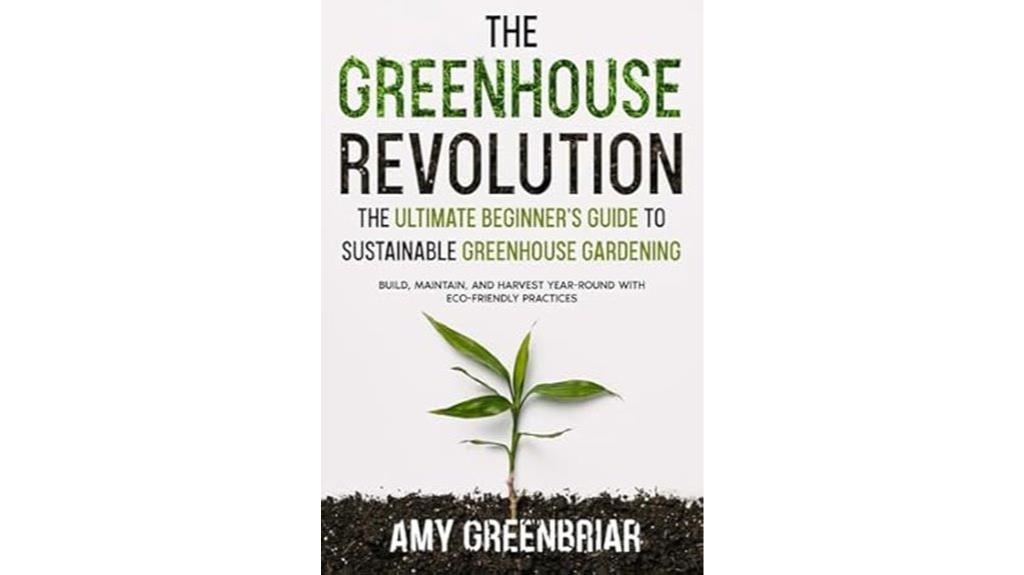
For anyone enthusiastic to plunge into the world of greenhouse gardening, "The Greenhouse Revolution: Ultimate Guide to Sustainable Greenhouse Gardening" is the perfect companion. This detailed guide covers everything from building to maintaining your greenhouse, ensuring you can harvest year-round. It emphasizes eco-friendly practices, offering tips on organic fertilizers and water-saving methods. With clear, manageable steps, even beginners can confidently create a thriving environment. The book's extensive resources on crop rotation, pest management, and layout optimization prepare you for success. I've found it invaluable in my own gardening journey, and I'm sure you will too!
Best For: This guide is best for both novice and experienced gardeners looking to cultivate a sustainable greenhouse environment year-round.
Pros:
- Comprehensive coverage of greenhouse gardening practices, from building to maintenance.
- Focus on sustainability with eco-friendly tips on organic fertilizers and water conservation.
- Clear, manageable steps make it accessible for beginners and helpful for seasoned gardeners.
Cons:
- Some advanced techniques may require additional research beyond the book's scope.
- Limited coverage on specific plant varieties and their unique needs.
- Readers may need to invest in additional materials or tools to fully implement the practices suggested.
The Greenhouse Gardeners Manual
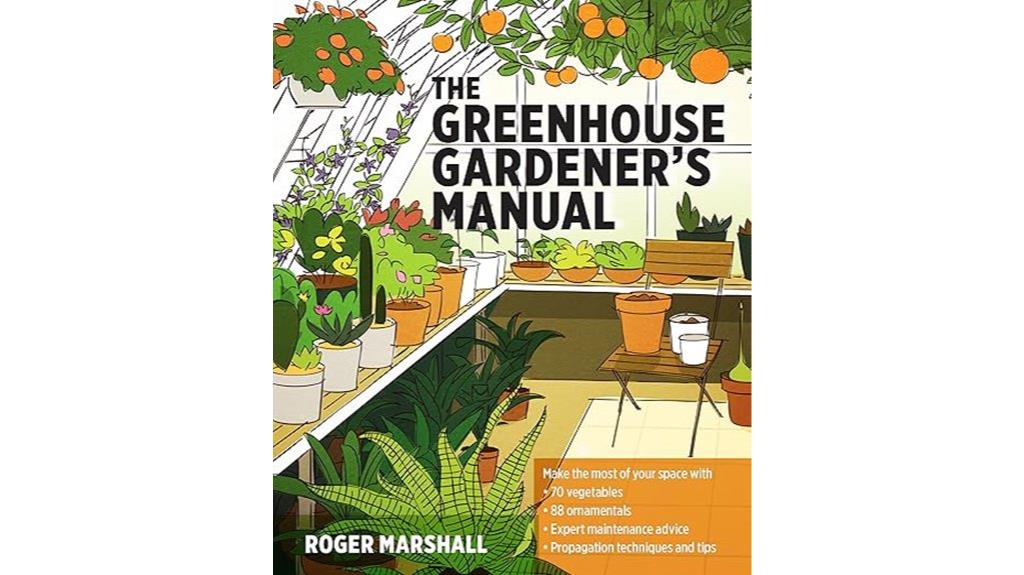
The Greenhouse Gardeners Manual stands out as an essential resource for anyone new to greenhouse gardening. It's incredibly informative, perfect for beginners like me, offering concise explanations paired with plenty of visuals. This book covers everything I needed to know, from building design to caring for my plants. I found practical guidance, such as the importance of a cement foundation and proper ventilation. With glowing reviews backing it up, I can see why it's recommended. As I shift to greenhouse gardening at 66, this manual is helping me create a more manageable gardening experience for the future.
Best For: Beginners looking to start greenhouse gardening with comprehensive guidance and practical tips.
Pros:
- Provides concise explanations and plenty of visuals, making it easy to understand for novices.
- Covers all essential aspects of greenhouse gardening, including design and plant care.
- Highly recommended by users, indicating strong satisfaction and effectiveness.
Cons:
- May be too basic for experienced gardeners seeking advanced techniques.
- Limited coverage of niche topics or specialized plant care.
- Some readers may prefer more in-depth information rather than concise summaries.
Greenhouse Gardening for Beginners: Build Your Own Greenhouse and Grow Organic Vegetables and Fruits
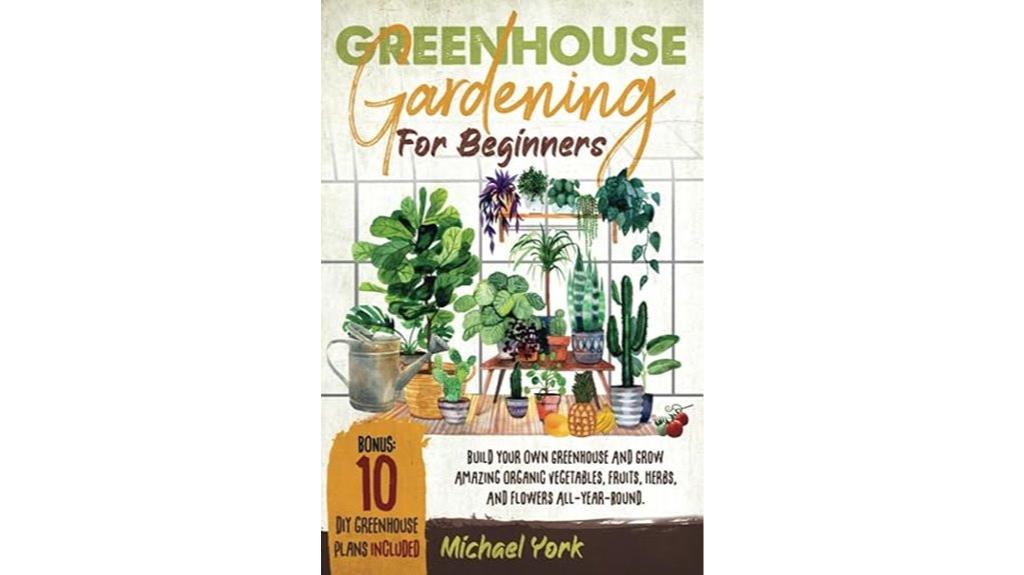
Looking to plunge into greenhouse gardening? "Greenhouse Gardening for Beginners" by Michael York is an ideal choice for anyone enthusiastic to cultivate organic vegetables and fruits but unsure where to start. This thorough guide breaks down greenhouse setup and maintenance, ensuring you manage temperature, humidity, and airflow effectively. With year-round planting calendars and beginner-friendly techniques, you'll quickly learn how to grow thriving plants. Plus, York includes clever DIY projects that save money while enhancing your gardening experience. Even if you find some aspects lacking, this book remains a fantastic starting point for building your own greenhouse and growing delicious organic produce.
Best For: Beginner gardeners and those interested in organic gardening who want to create a greenhouse for growing vegetables and fruits.
Pros:
- Comprehensive guide covering greenhouse setup, maintenance, and plant care.
- Includes a year-round planting calendar and beginner-friendly growing techniques.
- Features cost-saving DIY projects using recycled materials.
Cons:
- Some readers may find an excessive focus on greenhouse construction rather than gardening techniques.
- A lack of illustrations may limit understanding for visual learners.
- More extensive gardening information could enhance the overall value of the book.
The Complete Beginners Guide to Greenhouse Gardening
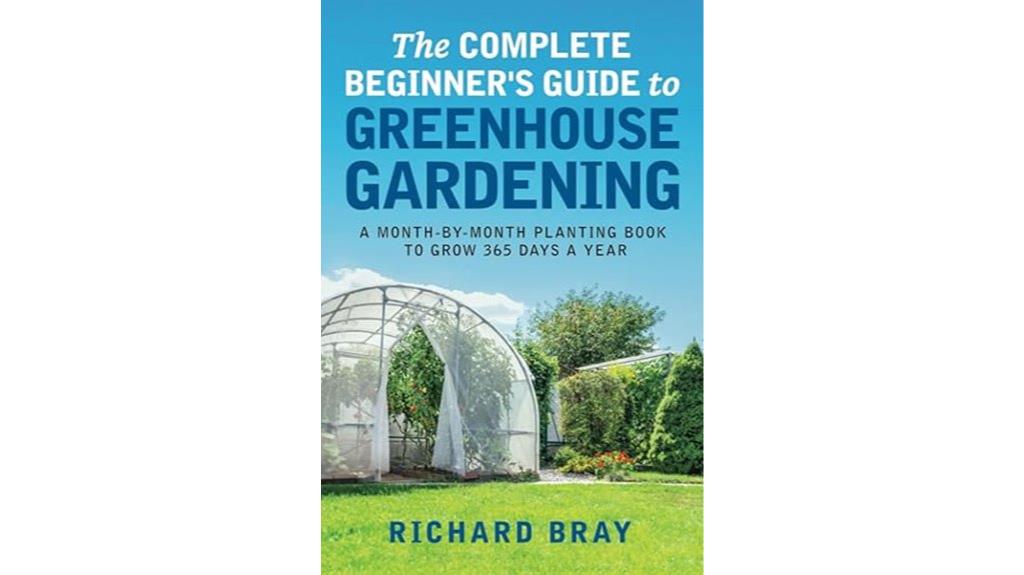
If you're enthusiastic to plunge into greenhouse gardening but feel overwhelmed by the options and techniques out there, this guide is perfect for you. It covers everything from choosing the right greenhouse type for your region to essential topics like crop rotation and pest management. You'll find practical advice on building your greenhouse, including design choices and location tips. The plant growing guides detail how to cultivate various fruits, vegetables, and herbs effectively. Plus, you'll discover techniques for both soil-based and hydroponic gardening. This all-encompassing resource will inspire your confidence and help you thrive as a greenhouse gardener.
Best For: Beginner gardeners looking to start greenhouse gardening with comprehensive guidance and practical advice.
Pros:
- Covers a wide range of topics including greenhouse construction, crop rotation, and pest management.
- Provides specific plant growing guides for fruits, vegetables, and herbs tailored to greenhouse environments.
- Includes techniques for both soil-based and hydroponic gardening, catering to diverse gardening preferences.
Cons:
- May contain overwhelming amounts of information for complete novices.
- Some readers might find the technical details on calculations and charts complex.
- Limited focus on advanced gardening techniques for experienced gardeners.
Effortless Greenhouse Gardening for Beginners
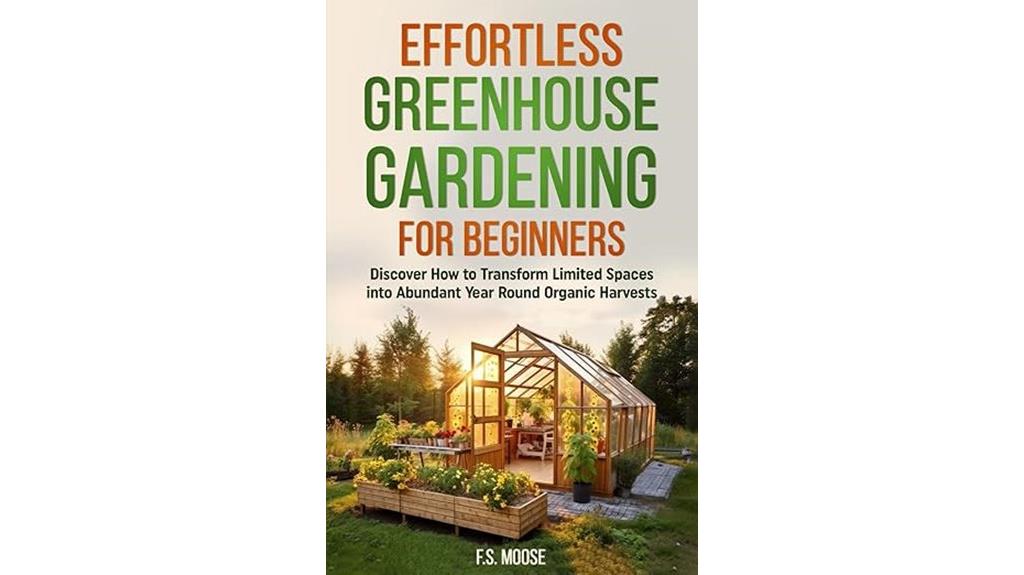
For those just starting their journey into greenhouse gardening, "Effortless Greenhouse Gardening for Beginners" stands out as an invaluable resource. This guide has everything I needed to set up my greenhouse, from planning and building to maintaining it year-round. I love the step-by-step instructions and beautiful images that make learning easy. The practical tips on plant selection, pest management, and preserving my harvest through canning have been game-changers. It's accessible for beginners like me, breaking down complex concepts into manageable steps. I highly recommend this book to anyone looking to cultivate their green thumb effortlessly!
Best For: Beginners who want to learn how to successfully set up and maintain a greenhouse garden with minimal effort.
Pros:
- Step-by-step instructions make it easy for novices to follow along.
- Beautiful images enhance understanding and engagement with the material.
- Practical tips on pest management and preserving harvests provide valuable knowledge for sustainable gardening.
Cons:
- May lack advanced techniques for seasoned gardeners looking for more challenging content.
- Some readers might find the focus on simplicity limiting if they seek more in-depth scientific explanations.
- Limited information on specific greenhouse structures or designs could leave some readers wanting more customization options.
Greenhouse Gardening for Beginners
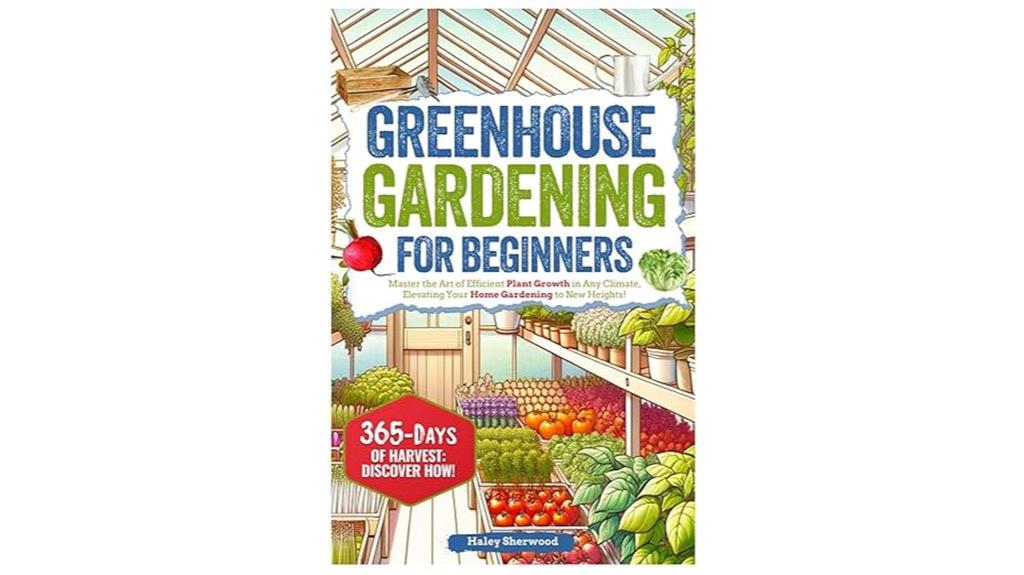
Greenhouse gardening is an ideal choice for anyone enthusiastic to grow fresh produce year-round, especially those who are just starting out. I found *Greenhouse Gardening for Beginners* by Haley Sherwood to be an invaluable resource. It offers easy-to-follow instructions on choosing the right greenhouse, managing temperature and humidity, and growing a variety of plants. I appreciated its practical tips on climate control and sustainable practices, which helped build my confidence. While the writing can be a bit flowery at times, the essential information shines through. This book is a great starting point for anyone keen to embrace greenhouse gardening!
Best For: Beginners and novice gardeners looking to start their greenhouse gardening journey and cultivate plants year-round.
Pros:
- Provides clear, step-by-step instructions on greenhouse selection and plant management.
- Offers practical tips on climate control and sustainable gardening practices.
- Emphasizes community engagement and eco-friendly gardening options.
Cons:
- Some readers may find the writing style overly poetic and detracting from the informative content.
- Not all aspects of greenhouse gardening are covered comprehensively.
- A few users may prefer a more straightforward, less stylistic approach to gardening literature.
Greenhouse Gardeners Companion: Growing Food & Flowers in Your Greenhouse
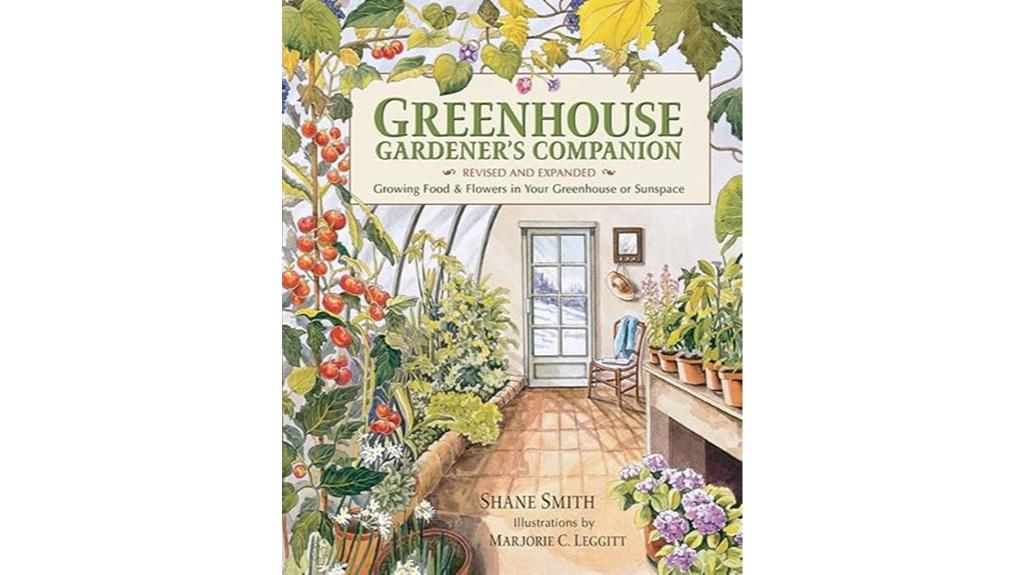
As a beginner gardener enthusiastic to immerse yourself in greenhouse gardening, you'll find "Greenhouse Gardeners Companion" to be an invaluable resource. This guide covers everything from greenhouse design to plant varieties, making it easy to navigate your new hobby. It offers practical tips on light, temperature, and even troubleshooting common issues like CO2 deficiency. You'll appreciate the insights on efficient growing techniques and money-saving ideas, helping you maximize your space. Many readers, including myself, have found success using its recommendations, whether growing winter vegetables or pollinating plants. Keep this book handy—it's a must-have for any greenhouse gardener!
Best For: Beginner and experienced gardeners looking to enhance their greenhouse gardening skills with practical guidance and tips.
Pros:
- Comprehensive coverage of greenhouse design, plant varieties, and growing techniques.
- Practical troubleshooting advice for common gardening issues like CO2 deficiency and artificial pollination.
- Money-saving tips and efficient techniques that help maximize growing space and resources.
Cons:
- Some information may not be applicable to all climates, potentially limiting its usefulness for certain gardeners.
- Beginners may require additional resources to fully understand advanced concepts discussed in the book.
- The book's thoroughness may feel overwhelming to those looking for quick reference or straightforward instructions.
The Greenhouse Revolution: Ultimate Beginners Guide to Sustainable Greenhouse Gardening
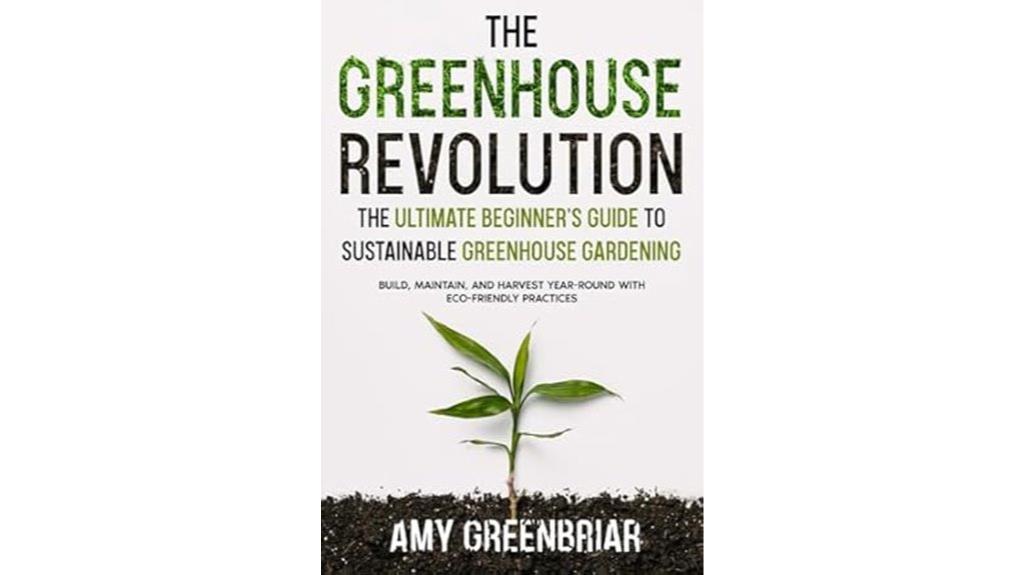
If you're new to gardening and want to create a sustainable oasis, "The Greenhouse Revolution" is the perfect guide for you. It's packed with practical advice on building and maintaining your greenhouse while emphasizing eco-friendly practices. I found the clear, manageable steps incredibly helpful, especially for planning year-round harvests. The book covers everything from organic fertilizers to pest management, ensuring you're well-prepared to tackle challenges. Plus, it encourages reducing your carbon footprint while enjoying fresh produce. This guide has become my go-to resource, helping me cultivate a thriving, sustainable environment right in my backyard.
Best For: Beginners and experienced gardeners looking to create a sustainable greenhouse environment.
Pros:
- Offers clear, manageable steps for building and maintaining a greenhouse.
- Emphasizes eco-friendly practices, helping reduce carbon footprints.
- Comprehensive coverage of topics including organic fertilizers, pest management, and crop rotation.
Cons:
- May contain more advanced techniques that could overwhelm absolute beginners.
- Focus on sustainability might not appeal to all gardening enthusiasts.
- Some readers might desire more in-depth coverage on specific plants or crops.
DREAM GREENHOUSE FOR BEGINNERS: THE ULTIMATE BEGINNER COURSE
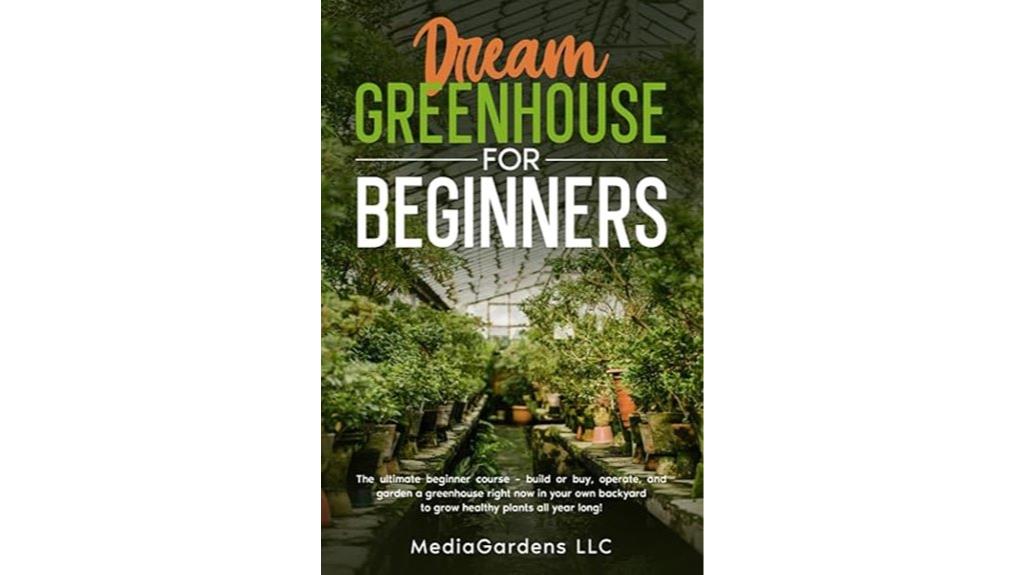
For anyone new to gardening and enthusiastic to create their own greenhouse oasis, "DREAM GREENHOUSE FOR BEGINNERS: THE ULTIMATE BEGINNER COURSE" is the perfect starting point. This thorough guide walks you through constructing or purchasing a greenhouse, making the process simple and accessible. You'll find practical tips on site selection, materials, and climate control, ensuring your greenhouse thrives. The book also covers essential plant care techniques, which helps you maximize growth year-round. Readers rave about its clear structure and informative content, boosting your confidence to engage in greenhouse gardening and enjoy growing your own fruits and vegetables.
Best For: Beginners looking to construct or purchase a greenhouse for growing their own fruits and vegetables.
Pros:
- Provides clear, step-by-step instructions for greenhouse construction and maintenance.
- Offers practical tips on plant care, climate control, and irrigation system setup.
- Tailored for novices, making it accessible and encouraging for new gardeners.
Cons:
- Some readers desire more specific references regarding nutrient management.
- May not cover advanced techniques for experienced gardeners.
- Limited information on specialized greenhouse types for extreme climates.
Greenhouse Gardening for Beginners: A Complete Guide to Growing in Your Greenhouse
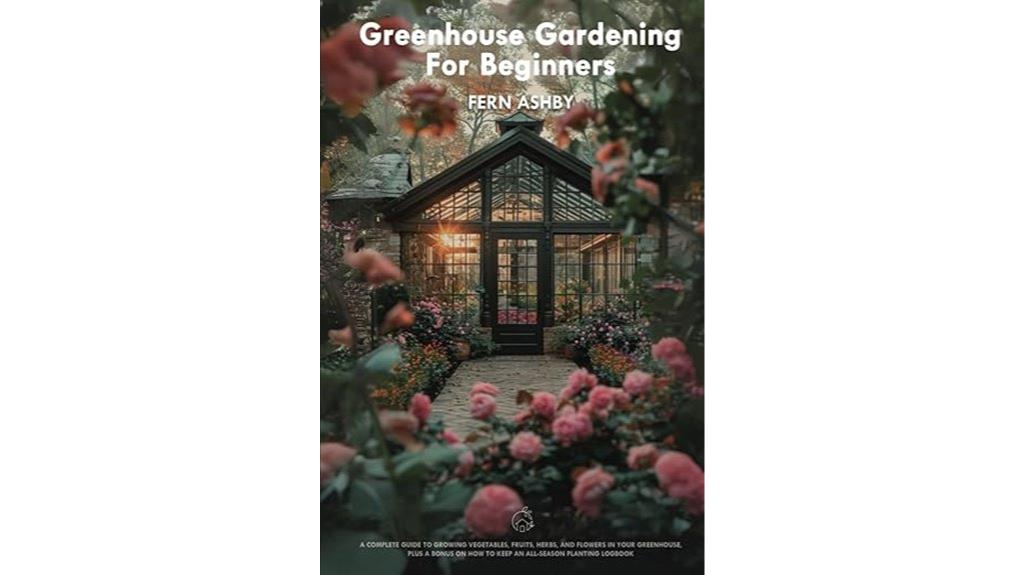
Greenhouse gardening can be a rewarding adventure, especially for those just starting out. I found "Greenhouse Gardening for Beginners" by Fern Ashby to be an invaluable resource. It guides you through selecting the right greenhouse and mastering sustainable gardening techniques. With clear instructions for growing vegetables, fruits, herbs, and flowers, it's perfect for newbies and seasoned gardeners alike. The practical tips on temperature control and space management really made a difference for me. I recommend this book to anyone dreaming of creating their own garden oasis—it's a must-read that inspires confidence and cultivates your green thumb!
Best For: This book is best for beginners and seasoned gardeners looking to enhance their greenhouse gardening skills and knowledge.
Pros:
- Provides clear instructions for growing a variety of plants, making it accessible for all skill levels.
- Offers practical tips on temperature control and space management to optimize gardening success.
- Inspires confidence and enthusiasm in readers, encouraging them to create their own personal garden oasis.
Cons:
- Some readers may find certain sections too basic if they have prior gardening experience.
- The focus on sustainable techniques may not appeal to all gardeners looking for traditional methods.
- Limited coverage on advanced gardening topics may leave experienced gardeners wanting more in-depth information.
Greenhouse Gardening – A Beginners Guide
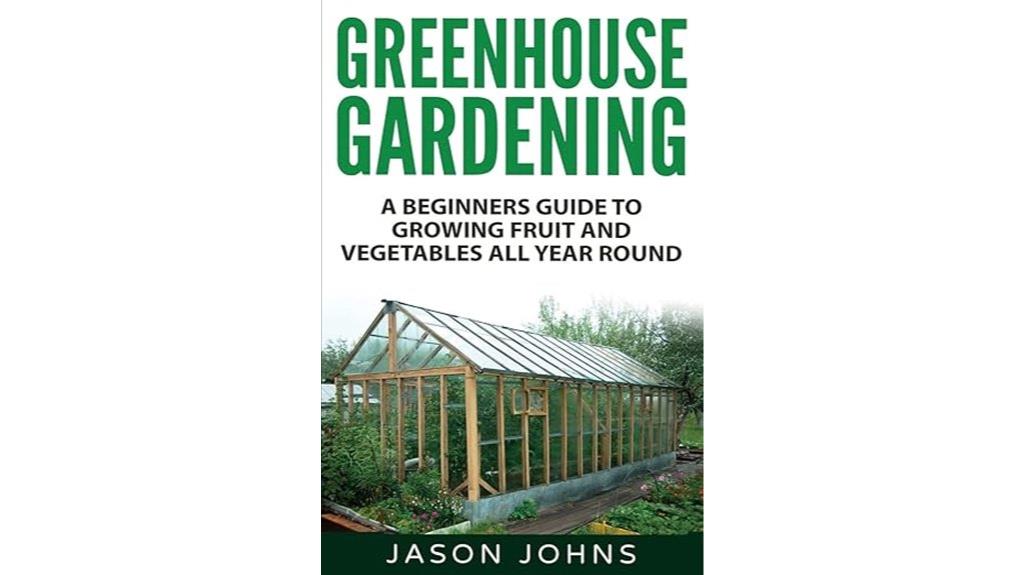
Starting your journey into greenhouse gardening can be exciting, especially if you're new to growing your own fruits and vegetables. I found "Greenhouse Gardening: A Beginners Guide" by Jason Johns incredibly helpful. It covers everything from selecting the right greenhouse to essential aspects like irrigation and ventilation. I learned how to extend my growing season and cultivate a variety of plants, including tomatoes and peppers. The practical advice on soil and pest management was invaluable. Overall, this guide is perfect for novices and even seasoned gardeners looking to refresh their skills. It's a must-have for anyone keen to grow successfully!
Best For: Beginners in gardening and those looking to enhance their skills in greenhouse gardening.
Pros:
- Easy-to-read format with practical advice suitable for novice gardeners.
- Covers a wide range of topics, including plant varieties and essential greenhouse setup.
- Valuable tips on pest management and soil care that benefit both new and experienced gardeners.
Cons:
- Some readers with prior gardening experience may find the content too basic.
- Technical issues reported with accessing the Kindle version may affect user experience.
- Limited depth on advanced techniques may leave seasoned gardeners wanting more.
Factors to Consider When Choosing Beginner Greenhouse Gardening
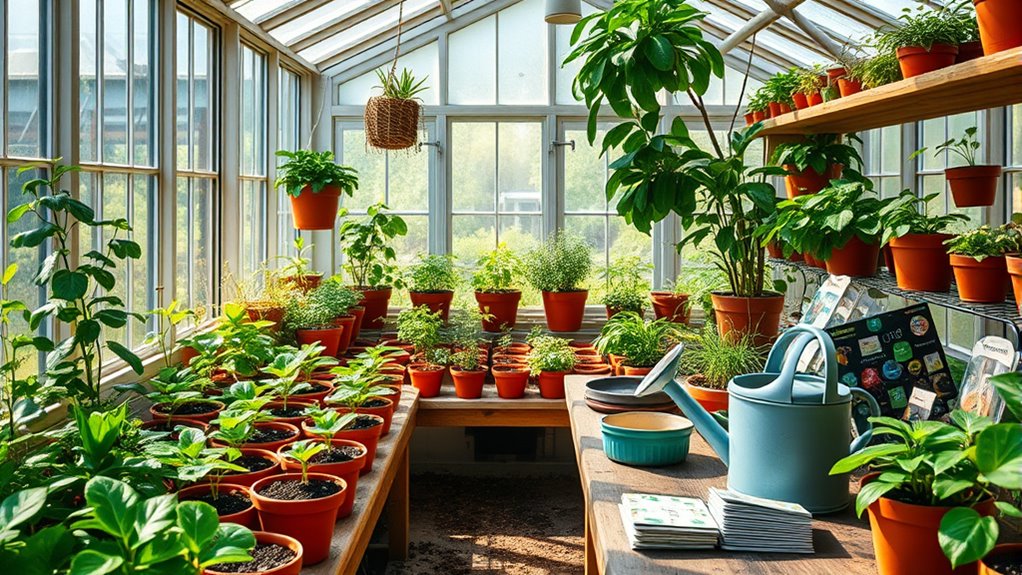
When I started my greenhouse journey, I quickly realized there are several key factors to take into account. From the type of greenhouse that suits your needs to the climate and budget, each decision plays a vital role in your success. Let's explore these important points together so you can set up your greenhouse for the best results.
Greenhouse Types Overview
Choosing the right type of greenhouse can be overwhelming, especially with so many options available. I've found that understanding the different types can really help narrow it down. Lean-to greenhouses are perfect if you're short on space, as they utilize an existing structure for support and are convenient for accessing utilities. On the other hand, freestanding greenhouses offer more design flexibility and placement options. If you're looking for a budget-friendly, temporary solution, hoop houses made from flexible tubing and plastic sheeting are easy to assemble. Don't forget to take into account the materials used, like glass or polyethylene, as they affect insulation and light diffusion, both essential for your plants' success. Choose wisely, and your green thumb will flourish!
Climate Considerations
After settling on the right type of greenhouse, the next step is to contemplate your local climate. Understanding local conditions is key since greenhouses can extend your growing season by creating a controlled environment. I've learned that temperature fluctuations impact plant growth, so choosing a design with good insulation and ventilation is essential. Managing humidity is also vital; I often adjust airflow and watering based on the climate to prevent mold and disease. If you live in an area with high sunlight, consider shading solutions to protect your plants from overheating. Finally, keep seasonal variations in mind—certain plants thrive in specific seasons, which can influence what you decide to grow year-round.
Budgeting and Costs
Budgeting for a beginner greenhouse can feel overwhelming, but breaking it down into manageable parts makes it easier. First, consider the structure itself—materials like wood, metal, or polycarbonate can vary widely in price based on quality. Then, think about site preparation costs; land clearing and leveling can add up quickly. Don't forget climate control systems, such as heaters and ventilation, which are essential for ideal growth. Ongoing expenses like water, soil, and pest management will also accumulate over time, affecting your budget. I recommend setting aside a contingency fund of about 10-15% of your total costs to cover unexpected expenses. This way, you're better prepared for any surprises that come your way as you start your greenhouse gardening journey.
Location Selection
When I think about selecting the right location for my greenhouse, I prioritize sunlight exposure, as it's essential for healthy plant growth. I aim for a spot that gets at least 6-8 hours of direct sunlight daily to maximize photosynthesis. Good drainage is another vital factor; I avoid low-lying areas where water can pool, preventing root rot. I also look for easy access to a water source, like a hose or faucet, to simplify my watering routine. Additionally, I consider wind exposure; placing the greenhouse in a sheltered area protects my plants from harsh winds that can cause temperature fluctuations. Finally, I assess proximity to power sources if I plan on using heating or cooling systems to enhance functionality.
Materials and Structures
Choosing the right materials and structure for my greenhouse is essential for creating an effective growing environment. I often lean towards polycarbonate or polyethylene film because they offer excellent insulation and UV protection, all while being lightweight and budget-friendly. It's important to design the structure with adequate ventilation; roof vents and side windows can help regulate airflow and temperature. For stability, I prefer a sturdy foundation using concrete or treated wood, especially in harsh weather. Additionally, I make sure to orient the greenhouse for maximum sunlight exposure, ensuring it gets direct light throughout the day. Finally, I consider my local climate; insulating materials work best in colder regions, while airflow-friendly options are ideal for hotter areas.
Size and Space
While I often dream of a sprawling greenhouse filled with diverse plants, the size and space I have available in my yard play an essential role in my decision-making process. I need to verify there's enough room not just for the greenhouse itself but also for my gardening activities. A minimum size of 6×8 feet is often recommended for beginners like me, providing enough space for basic growing while keeping maintenance manageable. I also consider the height—taller structures allow for vertical gardening and better light penetration. Plus, I take my local climate into account; in colder regions, a larger greenhouse might be necessary to maintain ideal conditions year-round. Planning wisely helps me grow successfully!
Ventilation and Heating
As I immerse myself in greenhouse gardening, I quickly realize that proper ventilation and heating are essential for keeping my plants healthy and thriving. Good ventilation prevents overheating and minimizes the risk of fungal diseases. I've learned that an ideal system includes both inlet and outlet vents, promoting cross-ventilation for better air circulation. When it comes to heating, I carefully consider my options—electric heaters, gas heaters, or even passive solar techniques. The placement and size of vents depend on my greenhouse's design and the local climate, ensuring effective airflow without compromising structure. I also monitor temperature and humidity levels with gauges, which helps me make informed decisions about when to ventilate or heat my greenhouse effectively.
Frequently Asked Questions
What Are the Best Plants for Beginners in Greenhouse Gardening?
When I started greenhouse gardening, I found that some plants are just easier for beginners. I'd recommend trying herbs like basil and parsley since they grow quickly and don't need much fuss. Lettuce and radishes are also great choices; they sprout fast and are forgiving. If you want flowers, marigolds and nasturtiums are hardy and add color. Starting with these makes it less overwhelming and helps build my confidence as a gardener!
How Much Sunlight Does a Greenhouse Need Daily?
Think of sunlight as the lifeblood of your greenhouse—without it, your plants might feel like fish out of water. I've found that most plants thrive with around six to eight hours of direct sunlight each day. It's essential to position your greenhouse wisely to capture that golden light. Keep an eye on your plants, though; if they start to stretch toward the light, it might be time to adjust their setup.
What Common Pests Should I Watch for in My Greenhouse?
When I started my greenhouse, I quickly learned to watch out for common pests. Aphids, spider mites, and whiteflies can wreak havoc on my plants. I've found that regularly inspecting my plants helps catch infestations early. I also keep an eye out for fungus gnats, especially in damp conditions. Using sticky traps and introducing beneficial insects like ladybugs has really helped me manage these pests effectively. It's all about staying proactive!
How Do I Maintain Optimal Humidity Levels in My Greenhouse?
Maintaining ideal humidity levels in my greenhouse is like keeping a delicate balance on a tightrope. I regularly check the humidity using a hygrometer, aiming for about 50-70%. If it gets too high, I open vents or use a fan to encourage airflow. When it's too low, I mist my plants or add a shallow water tray. By monitoring and adjusting, I create a perfect environment for my plants to thrive.
Can I Use Organic Fertilizers in My Greenhouse Garden?
Absolutely, I've used organic fertilizers in my greenhouse garden, and they've worked wonders! I love how they enrich the soil naturally, promoting healthy plant growth without harmful chemicals. When I apply them, I make sure to follow the recommended guidelines to avoid over-fertilizing. Plus, I enjoy knowing I'm supporting sustainable practices. Just be mindful of your plants' specific needs, and you'll see great results in no time!
Conclusion
To sum up, starting your greenhouse gardening journey can truly transform your life, turning you into a culinary wizard right in your backyard. By following these tips, you'll not only cultivate thriving plants but also gain the satisfaction of growing your own organic produce. Remember, every great gardener started as a beginner, so don't be afraid to dig in and get your hands dirty. Your green thumb is just waiting to bloom! Happy gardening!
